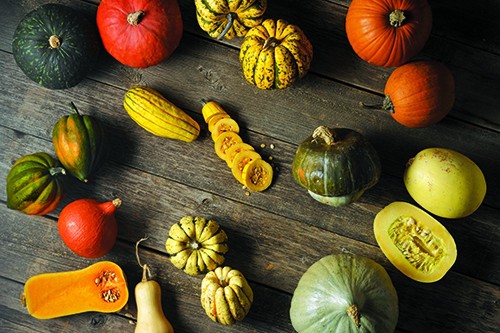
With origins in Mexico and Central America, winter squash was a staple crop among Native Americans, who ate the flowers, flesh and seeds of the plant and used the gourds as containers and utensils.
The name “winter squash” is a little deceptive. Though many are grown year-round, these gorgeous gourds are typically planted during warmer months and harvested before the first frost. When stored in cool, dry conditions, winter squash can be enjoyed throughout the late fall and winter — thus the name.
With few exceptions, such as spaghetti squash, winter squash is a good source of beta-carotene, vitamin C, potassium and fiber. The seeds — roasted or dried — are a great snack and a good source of protein and magnesium, among other nutrients.
Often enjoyed in cooler months, winter squash pack tons of flavor and remarkable versatility in the kitchen. Although these gourds can be eaten raw, the flesh takes on a smooth, creamy texture and flavors come alive when cooked. Winter squash can be enjoyed in sweet or savory preparations and often is roasted, though baking, boiling and microwaving also are common cooking methods. Season it with maple syrup, ginger or cinnamon, or add onion, garlic and herbs for a savory flavor.
Although all types feature a brilliant yellow or orange flesh inside, winter squash come in sizes large and small, and the outside can be smooth or bumpy and any shade of red, yellow, green and blue. A few have edible rinds, though most do not. Size varies from the 1- to 2-pound sweet dumpling to the hubbard squash, which can weigh more than 20 pounds.
Choose firm squash with no soft spots or blemishes and those that are heavy for their size.
Go beyond popular pumpkin and butternut squashes and explore new, flavorful ways to brighten any fall or winter plate.
Kabocha Squash
“Kabocha” is a Japanese word for squash. Less fibrous than other gourds, kabocha’s smooth yellow pulp is sweet with notes of honey and becomes custardy when cooked. Kabocha is ideal pureed for soup or pie filling and is available year-round in green and red varieties.
Acorn Squash
Shaped like its namesake, the acorn squash is available year-round. At only 1 to 2 pounds, acorn squash boasts chart-topping fiber at 9 grams per cup and delivers more than 25 percent of the recommended daily value of potassium. The tough exterior makes it ideal for roasting with the skin on.
Delicata Squash
Oblong with telltale green stripes, this squash boasts smooth, creamy flesh and sweet flavor. Delicata squash is delicious simply roasted or stuffed with whole grains or other savory fillings. Pair with Parmesan, nuts and woodsy herbs such as rosemary for a savory spin.
Butternut Squash
With gorgeous orange flesh and a mild, sweet flavor, butternut squash is an excellent source of vitamins C and A, with more than 6 grams of fiber per cup. Enjoy this gourd year-round roasted or tossed into soup, stew or smoothies.
Sweet Dumpling Squash
Sweet dumpling squash is the petite one of the bunch, weighing in at less than 2 pounds. With a tender, edible rind, the sweet dumpling squash can be cut in half, stuffed and roasted for a quick and colorful meal.
Red Kuri Squash
Sometimes called the baby red hubbard, red kuri squash is native to Japan. Its smooth and creamy yellow pulp has a chestnut-like flavor. Because of its hard rind, the red kuri is best roasted in the skin and scooped out to enjoy.
Sugar Pumpkin
Squat and sweet, the sugar pumpkin is one of the most popular winter squashes and provides fewer than 50 calories per cup. Roast or puree it into soup, pie filling and other desserts, or oatmeal. Always available, sugar pumpkin is commonly canned and available at supermarkets.
Carnival Squash
A hybrid of acorn and sweet dumpling squash, carnival squash looks like a party on the outside. Roasting brings out its rich, buttery and sweet flavor. Use it in any recipe as a substitute for acorn or butternut squash.
Buttercup Squash
Tough to peel when raw, buttercup squash boasts a sweet pulp that’s firm and somewhat dry. With a rich flavor akin to sweet potato, this gourd is best baked with the skin on, steamed or pureed.
Spaghetti Squash
Significantly lower in vitamin A than other squash, this pale yellow variety delivers a crunchy, stringy flesh resembling noodles when cooked. A nice substitute for pasta, the mild, slightly sweet flavor is a perfect canvas for olive oil or tomato-based sauces.
Hubbard Squash
With a dark green, orange or pale blue rind, hubbard squash can reach up to 20 pounds. The sweet, grainy flesh makes it ideal for mashing or pureeing into a sauce or filling for pie.








